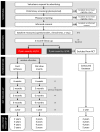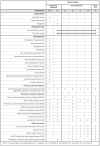The FOOTPATH study: protocol for a multicentre, participant- and assessor-blind, parallel group randomised clinical trial of foot orthoses for patellofemoral osteoarthritis
- PMID: 31005917
- PMCID: PMC6500302
- DOI: 10.1136/bmjopen-2018-025315
The FOOTPATH study: protocol for a multicentre, participant- and assessor-blind, parallel group randomised clinical trial of foot orthoses for patellofemoral osteoarthritis
Abstract
Introduction: Patellofemoral (PF) osteoarthritis (OA) is a common and burdensome subgroup of knee OA, with very little evidence for effective treatments. Prefabricated foot orthoses are an affordable and accessible intervention that have been shown to reduce PF pain in younger adults. Similarities between PF pain and PFOA, as well as our pilot work, suggest that foot orthoses may also be an effective intervention for PFOA. The primary objective of this study is to compare the 3 month efficacy of prefabricated foot orthoses and flat shoe inserts in people with PFOA, on knee pain severity.
Methods and analysis: The FOOTPATH Study (FOot OrThoses for PAtellofemoral osteoarTHritis) is a multicentre, randomised, participant- and assessor-blinded superiority trial with two parallel groups, a 3 month observation period (pre-randomisation) and 12 month follow-up. 160 participants with a clinical diagnosis of PFOA will be recruited from three sites in Australia, and randomised to one of two groups (prefabricated foot orthoses or flat shoe inserts). The primary outcome is worst knee pain severity during a self-nominated aggravating activity in the previous week (100 mm visual analogue scale) at 3 months, with a secondary endpoint at 12 months. Secondary outcomes include global rating of change, symptoms, function, health-related quality of life, kinesiophobia, self-efficacy and use of co-interventions for knee pain. Blinded, intention-to-treat analyses of primary and secondary patient-reported outcomes will be performed, as well as economic analyses.
Ethics and dissemination: Ethical approval has been granted by La Trobe University's Human Ethics Committee and The University of Queensland's Medical Research Ethics Committee. Study outcomes will be disseminated via peer-reviewed journals, conference presentations targeting a range of healthcare disciplines and an open access website with clinician resources.
Trial registration number: ANZCTRN12617000385347; Pre-results.
Keywords: clinical trials; knee; rheumatology.
© Author(s) (or their employer(s)) 2019. Re-use permitted under CC BY-NC. No commercial re-use. See rights and permissions. Published by BMJ.
Conflict of interest statement
Competing interests: BV reports non-financial support from Vionic, outside the submitted work. He is a member (non-paid affiliation) of the Vasyli Think Tank, which was founded in 2011 to foster collaboration and cooperative thought among a leading group of health professionals specialising in the field of lower limb biomechanics.
Figures





Similar articles
-
HAPPi Kneecaps! A double-blind, randomised, parallel group superiority trial investigating the effects of sHoe inserts for adolescents with patellofemoral PaIn: phase II feasibility study.J Foot Ankle Res. 2021 Dec 10;14(1):64. doi: 10.1186/s13047-021-00498-0. J Foot Ankle Res. 2021. PMID: 34893092 Free PMC article. Clinical Trial.
-
HAPPi Kneecaps! Protocol for a participant- and assessor-blinded, randomised, parallel group feasibility trial of foot orthoses for adolescents with patellofemoral pain.J Foot Ankle Res. 2020 Aug 2;13(1):50. doi: 10.1186/s13047-020-00417-9. J Foot Ankle Res. 2020. PMID: 32741375 Free PMC article. Clinical Trial.
-
A single-blinded, randomized, parallel group superiority trial investigating the effects of footwear and custom foot orthoses versus footwear alone in individuals with patellofemoral joint osteoarthritis: a phase II pilot trial protocol.J Foot Ankle Res. 2017 Apr 26;10:19. doi: 10.1186/s13047-017-0200-y. eCollection 2017. J Foot Ankle Res. 2017. PMID: 28450898 Free PMC article. Clinical Trial.
-
Prefabricated contoured foot orthoses to reduce pain and increase physical activity in people with hip osteoarthritis: protocol for a randomised feasibility trial.BMJ Open. 2022 Sep 6;12(9):e062954. doi: 10.1136/bmjopen-2022-062954. BMJ Open. 2022. PMID: 36691129 Free PMC article.
-
Foot osteoarthritis: latest evidence and developments.Ther Adv Musculoskelet Dis. 2018 Apr;10(4):91-103. doi: 10.1177/1759720X17753337. Epub 2018 Jan 23. Ther Adv Musculoskelet Dis. 2018. PMID: 29619094 Free PMC article. Review.
Cited by
-
HAPPi Kneecaps! A double-blind, randomised, parallel group superiority trial investigating the effects of sHoe inserts for adolescents with patellofemoral PaIn: phase II feasibility study.J Foot Ankle Res. 2021 Dec 10;14(1):64. doi: 10.1186/s13047-021-00498-0. J Foot Ankle Res. 2021. PMID: 34893092 Free PMC article. Clinical Trial.
-
Associations of foot and ankle characteristics with knee symptoms and function in individuals with patellofemoral osteoarthritis.J Foot Ankle Res. 2020 Sep 23;13(1):57. doi: 10.1186/s13047-020-00426-8. J Foot Ankle Res. 2020. PMID: 32967701 Free PMC article. Clinical Trial.
-
Physical Therapist Management of Anterior Knee Pain.Curr Rev Musculoskelet Med. 2020 Dec;13(6):776-787. doi: 10.1007/s12178-020-09678-0. Epub 2020 Oct 30. Curr Rev Musculoskelet Med. 2020. PMID: 33128200 Free PMC article. Review.
-
HAPPi Kneecaps! Protocol for a participant- and assessor-blinded, randomised, parallel group feasibility trial of foot orthoses for adolescents with patellofemoral pain.J Foot Ankle Res. 2020 Aug 2;13(1):50. doi: 10.1186/s13047-020-00417-9. J Foot Ankle Res. 2020. PMID: 32741375 Free PMC article. Clinical Trial.
References
Publication types
MeSH terms
Associated data
LinkOut - more resources
Full Text Sources
